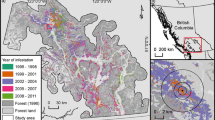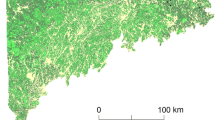Abstract
This work is dedicated to discussing the possibilities of describing the dynamics of forest insect outbreaks on different spatial scales. The properties of outbreaks are considered on a microspatial scale, where the distribution patterns of individuals across different food sources within the boundaries of a local territory or a stand are analyzed and, on a macrospatial scale, where the focus of the analysis are the indicators of the removal of the photosynthetic apparatus (leaves or needles) over the entire territory of the locus, including primary, secondary, and migratory loci. When analyzing the microspatial distribution of caterpillars on trees within loci on different stages of gradation, the model of the distribution of individuals on fodder trees is used as a second-order stage transition. The macrospatial processes that occur during the outbreak development include, first, the growth of an existing outbreak and the emergence of new connected damaged areas of the forest, and, second, the emergence of new unconnected secondary foci. To characterize the outbreaks, their fractal dimension D and the characteristics of the “viscous fingers” on the border of the outbreaks are used. Remote sensing data are used to calculate these characteristics. The proposed approaches can be used to predict the development of a forest insect outbreak. When constructing and verifying the models, we used data from the Siberian silk moth census and the tree colonization rate in the outbreak zone, as well as the remote sensing data on the areas and shapes of the foci in the districts of Krasnoyarsk krai during an outbreak of the Siberian silk moth Dendrolimus sibiricus Tschetv. in 2015–2019.















Similar content being viewed by others
REFERENCES
Anderson, T., Statisticheskii analiz vremennykh ryadov (The Statistical Analysis of Time Series), Moscow: Mir, 1976.
Anderson, T.M. and Dragicevic, S., Network-agent based model for simulating the dynamic spatial network structure of complex ecological systems, Ecol. Model., 2018, vol. 389, pp. 19–32.
Barbour, D.A., Synchronous fluctuations in spatially separated populations of cyclic forest insects, in Population Dynamics of Forest Insects, Andover: Intercept, 1990, pp. 339–346.
Boldaruev, V.O., Dinamika chislennosti sibirskogo shelkopryada i ego parazitov (Population Dinamics of White-Lined Silk Moth and its Parasites), Ulan-Ude: Buryat. Knizh. Izd., 1969.
Charbonneau, D., Lorenzetti, F., Doyon, F., and Mauffette, Y., The influence of stand and landscape characteristics on forest tent caterpillar (Malacosoma disstria) defoliation dynamics: the case of the 1999–2002 outbreak in northwestern Quebec, Can. J. For. Res., 2012, vol. 42, pp. 1827–1836.
Cooke, B.J. and Roland, J., Trembling aspen responses to drought and defoliation by forest tent caterpillar and reconstruction of recent outbreaks in Ontario, Can. J. For. Res., 2007, vol. 37, no. 9, pp. 1586–1598.
Cooke, B.J., MacQuarrie, C.J.K., and Lorenzetti, F., The dynamics of forest tent caterpillar outbreaks across east-central Canada, Ecography, 2012, vol. 35, pp. 422–435.
Feder, E., Fraktaly (Fractals), Moscow: Mir, 1991.
Fisher, R.A., The wave of advance of advantageous genes, Annals Eugenics, 1937, vol. 7, pp. 355–369.
Isaev, A.S, Soukhovolsky, V.G., Tarasova, O.V., Palnikova, E.N., and Kovalev, A.V., Forest Insect Population Dynamics, Outbreaks and Global Warming Effects New York: Wiley, 2017.
Kleman, M. and Lavrentovich, O.D., Osnovy fiziki chastichno uporyadochennykh sred (Fundamentals of Physics of Partially Ordered Media), Moscow: Fizmatlit, 2007.
Knyazeva, S.V., Koroleva, N.V., Eidlina, S.P., and Sochilova, E.N., Health of vegetation in the area of mass outbreaks of Siberian moth based on satellite data, Contemp. Probl. Ecol., 2019, vol. 12, no. 7, pp. 743–752
Kolmogorov, A.N., Petrovskii, I.G., and Piskunov, N.S., A study of the diffusion equation with increase in the amount of substance, and its application to a biological problem, Byull. Mosk. Gos. Univ., Ser. A: Mat. Mekh., 1937, vol. 1.
Kondakov, Y.P., Regularities of the outbreaks of Siberian silk moth, in Ekologiya populyatsii lesnykh zhivotnykh Sibiri (Population Ecology of the Forest Animals in Siberia), Novosibirsk: Nauka, 1974, pp. 206–265.
Pesenko, Y.A., Printsipy i metody kolichestvennogo analiza v faunisticheskikh issledovaniyakh (Principles and Methods of Quantitative Analysis in Studies of Fauna), Moscow: Nauka, 1982.
Robert, L.E., Sturtevant, B.R., Cooke, B.J., James, P.M., Fortin, M.J., Townsend, P.A., Wolter, P.T., and Kneeshaw, D., Landscape host abundance and configuration regulate periodic outbreak behavior in spruce budworm (Choristoneura fumiferana Clem.), Ecography, 2018, vol. 41, pp. 1556–1571.
Robert, L.-E., Sturtevant, B.R., Kneeshaw, D., James, P.M.A., Fortin, M.-J., Wolter, P.T., Townsend, P.A., and Cooke, B.J., Forest landscape structure influences the cyclic-eruptive spatial dynamics of forest tent caterpillar outbreaks, Ecosphere, 2020, vol. 11, no. 8, p. e03096. https://doi.org/10.1002/ecs2.3096
Sasskind, L., Bitva pri chernoi dyre (The Black Hole War), St. Petersburg: Piter, 2013.
Schroeder, M., Fractals, Chaos, Power Laws, New York: W.H. Freeman, 1991
Sentinel Hub EO Browser. https://apps.sentinel-hub.com/eo-browser/.
Soukhovolsky, V. and Ivanova, Y., Modeling production processes in forest stands: an adaptation of the solow growth model, Forests, 2018, no. 9, pp. 391–403.
Soukhovolsky, V., Kovalev, A., Tarasova, O., et al., Wind damage and temperature effect on tree mortality caused by Ips typographus L.: Phase transition model, Forests, 2022, vol. 13, no. 2. https://doi.org/10.3390/f13020180
Soukhovolsky, V.G., Pal’nikova, E.N., Tarasova, O.V., and Karlyuk, A.Y., The model of forest insect outbreak as second order phase transition, Dokl. Biochem. Biophys., 2005, vol. 403, no. 4, pp. 297–299.
Soukhovolsky, V.G., Tarasova, O.V., and Kovalev, A.V., Modeling of carbon emission in the course of forest insect outbreaks, Lesovedenie, 2006, no. 5, pp. 22–28.
Soukhovolsky, V.G., Iskhakov, T.R., and Tarasova, O.V., Optimizatsionnye modeli mezhpopulyatsionnykh vzaimodeistvii (Optimization Models of Interpopulation Interactions), Novosibirsk: Nauka, 2008.
Sutton, A. and Tardif, J., Dendrochronological reconstruction of forest tent caterpillar outbreaks in time and space, western Manitoba, Canada, Can. J. For. Res., 2007, vol. 37, no. 9, pp. 1643–1657.
Svirezhev, Y.M., Nelineinye volny, dissipativnye struktury i katastrofy v ekologii (Nonlinear Waves, Dissipative Structures and Catastrophes in Ecology), Moscow: Nauka, 1987.
Tarasevich, Y.Y., Perkolyatsiya: teoriya, prilozheniya, algoritmy (Percolation: Theory, Applications, Algorithms), Moscow: Editorial URSS, 2002.
Tarasova, O.V., Kalashnikova, I.I., and Kuznecsova, V.V., Energy balance of forage consumption by phyllophagous insects: optimization model, Sib. Lesn. Zh., 2015, no. 3, pp. 83–92.
Wolter, P.T., Townsend, P.A., Sturtevant, B.R., and Kingdon, C.C., Remote sensing of the distribution and abundance of host species for spruce budworm in Northern Minnesota and Ontario, Remote Sens. Environ., 2008, vol. 112, no. 10, pp. 3971–3982.
Funding
This work was carried out with financial support from the Russian Science Foundation, grant no. 22-24-00148.
Author information
Authors and Affiliations
Corresponding author
Ethics declarations
ETHICS APPROVAL AND CONSENT TO PARTICIPATE
This work does not contain any studies involving human and animal subjects.
CONFLICT OF INTEREST
The authors of this work declare that they have no conflicts of interest.
Additional information
Publisher’s Note.
Pleiades Publishing remains neutral with regard to jurisdictional claims in published maps and institutional affiliations.
Rights and permissions
About this article
Cite this article
Soukhovolsky, V.G., Ivanova, Y.D. & Kovalev, A.V. Development of Outbreaks of Forest Insects on Different Spatial Scales. Contemp. Probl. Ecol. 16, 1017–1030 (2023). https://doi.org/10.1134/S1995425523070120
Received:
Revised:
Accepted:
Published:
Issue Date:
DOI: https://doi.org/10.1134/S1995425523070120




